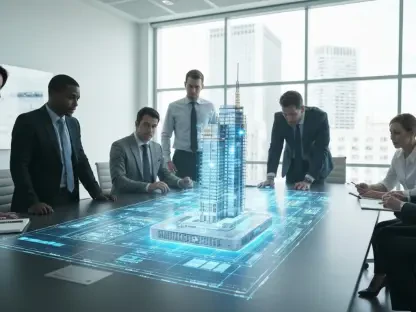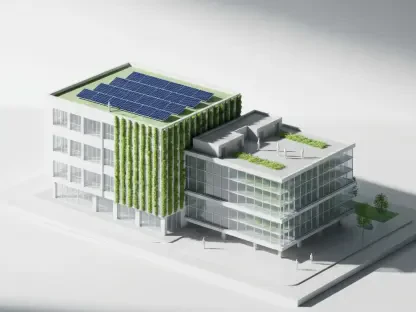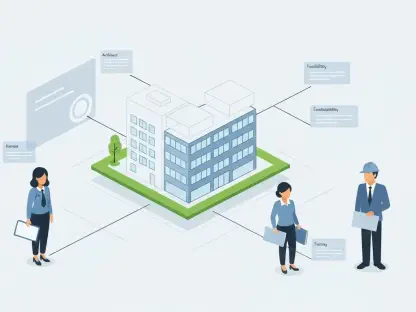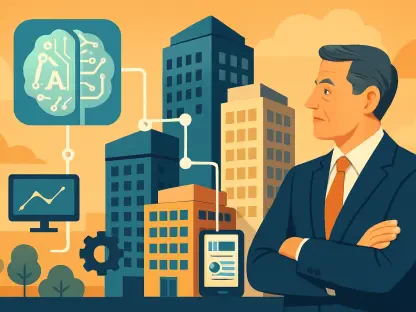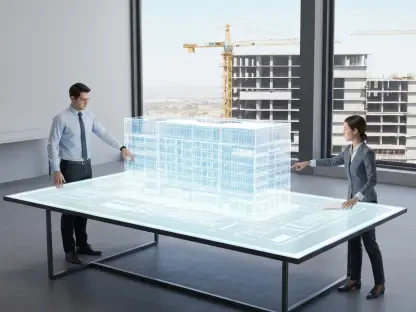The realm of seismic design is on the cusp of a profound transformation, driven by rapid advancements in technology and materials science. In areas prone to earthquakes, the imperative to construct buildings that can resiliently withstand seismic forces is greater than ever. The integration of cutting-edge technologies such as artificial intelligence (AI), the Internet of Things (IoT), and shape-memory alloys (SMAs) is enabling engineers and architects to redefine the foundational strategies of earthquake-resistant construction. These developments promise not only to fortify individual structures but also to enhance the overall resilience of urban environments. As urbanization accelerates, especially in seismic hotspots, the need for innovative approaches to seismic design becomes increasingly critical. The traditional methods, while still valuable, must evolve to incorporate modern tools and insights that can offer more precise, data-driven solutions. By blending tried-and-true engineering principles with technological advancements, the future of seismic design is poised to protect communities more effectively against the unpredictable forces of nature.
Advanced Seismic Design Concepts
In today’s technologically advanced era, seismic design is undergoing a fundamental shift through the adoption of innovative methodologies and materials. One prominent development is the use of damping systems that function as shock absorbers, effectively minimizing the impact of seismic vibrations on buildings. These systems exploit principles of physics to counteract the forces exerted during an earthquake, thereby preserving the structural integrity of tall buildings and complex infrastructures. A leading example of this is the implementation of mass dampers in skyscrapers, which are being utilized in seismic areas to maintain stability.
Another groundbreaking concept gaining traction is seismic cloaking. This technique cleverly diverts seismic waves away from structures, reducing the destructive energy that reaches foundations. Despite its complexity, this intriguing strategy shows promise in increasing the resilience of critical infrastructure. In tandem with these innovations, the use of flexible foundations is proving to be a successful approach in cushioning buildings from lateral ground movements. By functioning like ball bearings beneath structures, these foundations enable a degree of movement that disperses seismic energy, mitigating the risk of severe damage. These advanced techniques signal a shift towards more sophisticated responses to the seismic challenges facing modern society.
AI and IoT in Seismic Resilience
Artificial intelligence is actively reshaping the landscape of seismic design by offering accurately simulated scenarios of seismic events, which assist architects and engineers in crafting more resilient structures. Through the power of machine learning and AI algorithms, designers can predict a building’s behavior under various seismic conditions, leading to optimized design strategies that consider numerous complexities. Such simulations accelerate the design process and offer substantial cost savings by avoiding trial and error in physical building models. By integrating AI with construction methods, a new dimension of precision is emerging in architectural planning.
Complementing this is the role of IoT in developing smart infrastructure capable of real-time monitoring. IoT sensors installed within structures provide continuous feedback on their health and detect early signs of stress or damage caused by seismic activity. These devices not only assist in monitoring building conditions during and after earthquakes but also facilitate rapid response actions, such as automated safety protocols that prevent secondary disasters. By harnessing the power of real-time data, IoT ensures a proactive approach in managing seismic risk, thus offering invaluable insights into the stability of constructions and the safety of their occupants.
New Materials and Resilient Designs
The development of shape-memory alloys (SMAs) represents a significant breakthrough in the quest for more resilient constructions in earthquake-prone regions. These materials possess remarkable properties—namely, the ability to return to their original shape after deformation. By integrating SMAs into construction, buildings can absorb and dissipate seismic energy more effectively than with traditional materials. This capability significantly reduces structural strain during earthquakes and enhances the buildings’ energy absorption, potentially revolutionizing the approach to earthquake engineering.
Another promising area involves the use of innovative materials in combination with advancements such as flexible supports and complex damping systems. Employing these methods prompts a reevaluation of traditional materials like concrete and steel, creating hybrid frameworks that provide enhanced resistance to varying stress loads. Moreover, constructing new buildings with these designated materials not only mitigates the immediate impact of seismic events but also extends the lifespan of the buildings themselves. The practical application of these materials is already being tested and could soon become standard practice in seismic designs.
Current Trends and Strategic Recommendations
The trend toward integrating smart technology in seismic design is increasingly gaining momentum, with firms adapting to blend modern advancements seamlessly into existing frameworks. This movement reflects a broader recognition that traditional engineering practices must evolve to incorporate advanced technological solutions for seismic resilience. Emphasizing AI, IoT, flexible materials, and damping technologies highlights a collective endeavor to anticipate and respond effectively to the challenges posed by earthquakes.
Strategically, it is crucial to evaluate existing structures for potential weaknesses, particularly older buildings that may not conform to modern seismic codes. Retrofitting such buildings with smart technology and enhanced materials can significantly strengthen their capacity to withstand seismic activity. In addition, investing in continued research and collaboration across industry sectors can propel the development of cost-effective solutions that prioritize public safety. By exploring advanced materials and techniques, such as seismic cloaking for vital infrastructure, the construction industry can remain at the forefront of innovation, committed to safeguarding urban landscapes.
Future Considerations for Seismic Design
Seismic design is on the brink of a significant shift, driven by rapid advancements in technology and materials science. In earthquake-prone regions, the necessity for buildings that can endure seismic forces is more crucial than ever. The integration of advanced technologies like artificial intelligence (AI), the Internet of Things (IoT), and shape-memory alloys (SMAs) is enabling engineers and architects to redefine the core strategies of earthquake-resistant construction. These innovations promise to fortify structures and enhance the resilience of urban environments as a whole. As urbanization surges, especially in seismic areas, the demand for creative seismic design approaches becomes increasingly pressing. Traditional methods remain valuable but must evolve to incorporate these cutting-edge tools and insights for precise, data-driven solutions. By merging established engineering principles with modern advancements, the future of seismic design is set to safeguard communities more effectively against the unpredictable forces of nature, ensuring safer, more resilient habitats.





